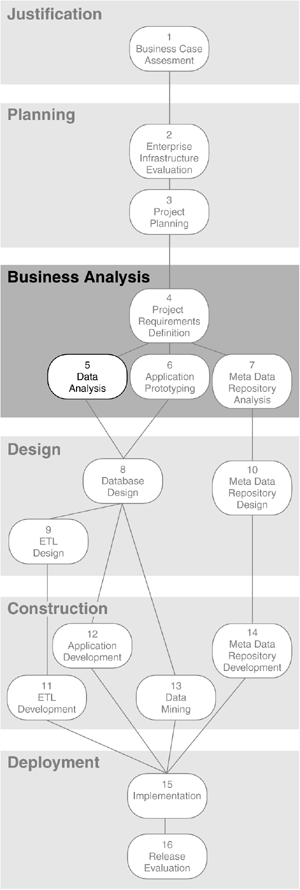|  Chapter Overview This chapter covers the following topics: -
Things to consider when analyzing source data for BI applications -
The difference between the systems analysis phase of a traditional methodology and the business-focused data analysis performed during this step -
Top-down logical data modeling, including project-specific logical data models, integrated enterprise logical data models, and data-specific business meta data components gathered during the logical data modeling process -
Bottom-up source data analysis, including how to apply three sets of transformation rules to the source data: technical data conversion rules, business data domain rules, and business data integrity rules -
The responsibilities for data archeology, data cleansing, and data quality enforcement, plus the need to triage (prioritize) data-cleansing activities -
Brief descriptions of the activities involved in data analysis, the deliverables resulting from those activities, and the roles involved -
The risks of not performing Step 5 Things to Consider Source Data  Do we know where the source data resides? In what systems? In what files? In what databases? Do we know where the source data resides? In what systems? In what files? In what databases?  Are there multiple potential sources for the same data? Are there multiple potential sources for the same data?  Has the requested source data already been modeled ? Has the requested source data already been modeled ?  How current is the business meta data on those models? How current is the business meta data on those models?  Have the data owners ratified the business meta data? Have the data owners ratified the business meta data?  Do we know who the data owners are? Who has authority over the source data? Do we know who the data owners are? Who has authority over the source data?  Is there any other type of documentation available for the requested source data? Is it current and complete? Is there any other type of documentation available for the requested source data? Is it current and complete?  Where is that documentation? In a meta data repository? In programs? In manuals? Where is that documentation? In a meta data repository? In programs? In manuals? Data Quality  Do we know how clean the source data is? Do we know how clean the source data is?  How clean does the data have to be according to our business representative? How clean does the data have to be according to our business representative?  Will that be clean enough for other knowledge workers, business analysts, and business managers who will use the same data? Will that be clean enough for other knowledge workers, business analysts, and business managers who will use the same data?  Do we know who they are? Do we know who they are?  Where do we get the business rules for the data? From the data owners? From the business representative on the project? Where do we get the business rules for the data? From the data owners? From the business representative on the project? Data Cleansing  Have data errors already been documented by other project teams ? If so, where is that documentation? Have data errors already been documented by other project teams ? If so, where is that documentation?  Who would know what the known data errors are? Who would know what the known data errors are?  Are codes being translated inside operational programs? If so, in which programs? Are codes being translated inside operational programs? If so, in which programs?  Does a code translation book exist for encoded fields? Does a code translation book exist for encoded fields?  Do we already know which data is critical, which is important, and which is insignificant (for data-cleansing triage purposes)? Do we already know which data is critical, which is important, and which is insignificant (for data-cleansing triage purposes)? | Operational systems are developed as stovepipe automation solutions for individual business units and not as support for the executive decision-making process. Therefore, operational systems are not designed to integrate or reconcile with each other in order to provide a consistent cross-organizational view. BI applications, on the other hand, are designed to do just that ”provide integrated and reconciled business data to the business community.  |

 Do we know where the source data resides? In what systems? In what files? In what databases?
Do we know where the source data resides? In what systems? In what files? In what databases?